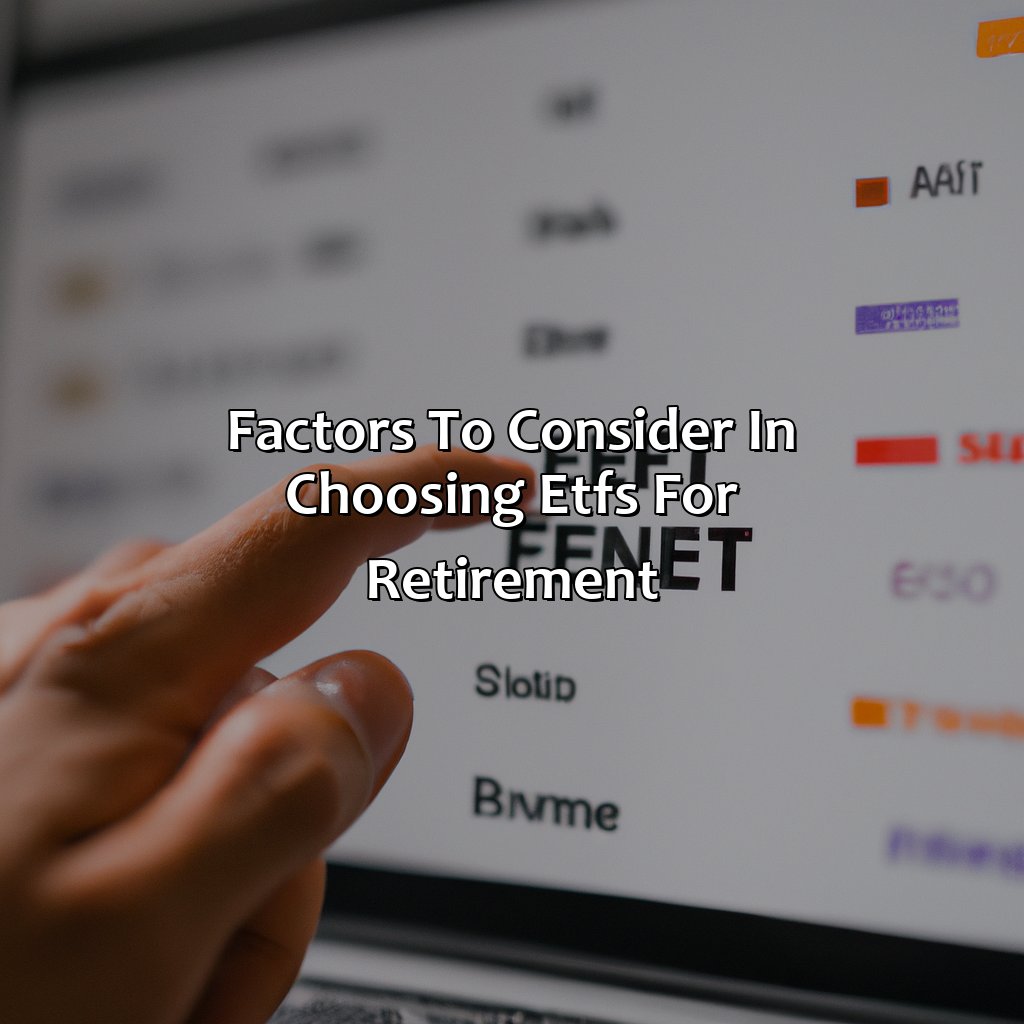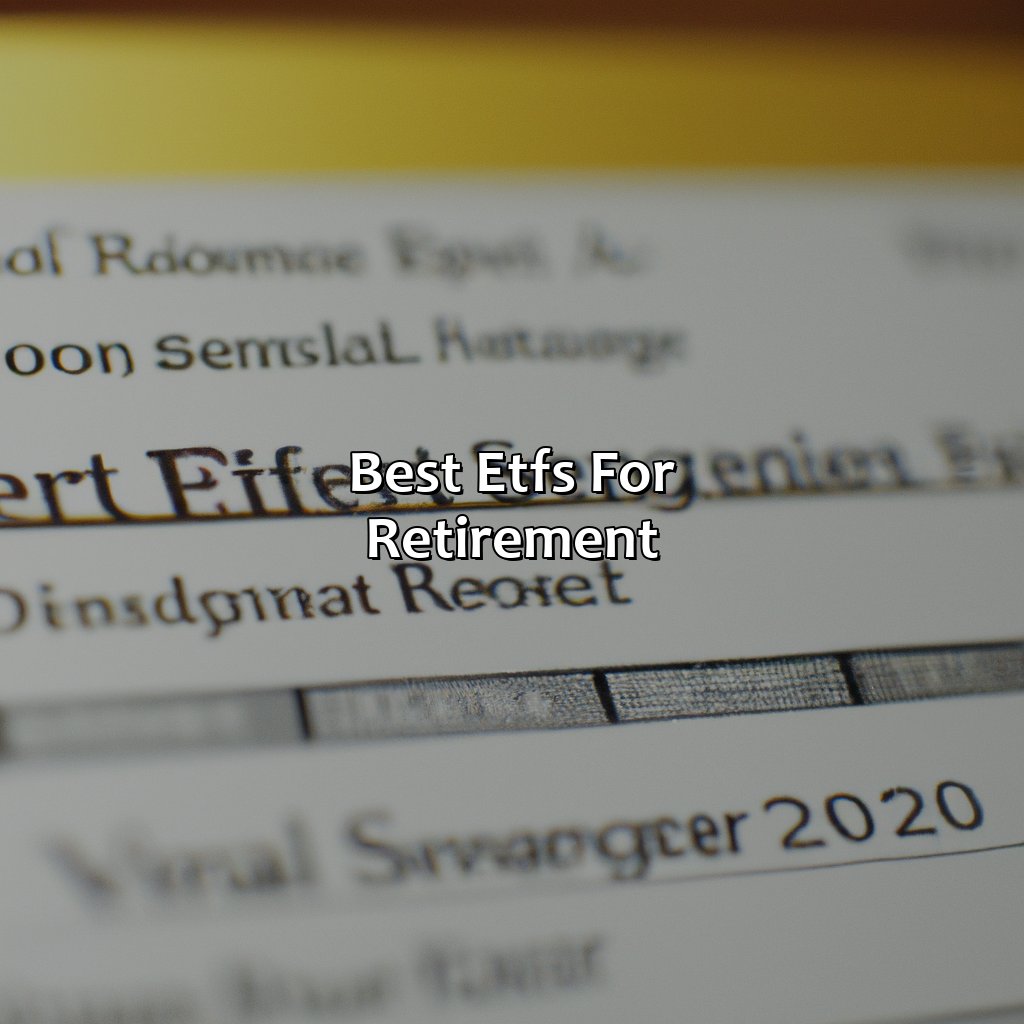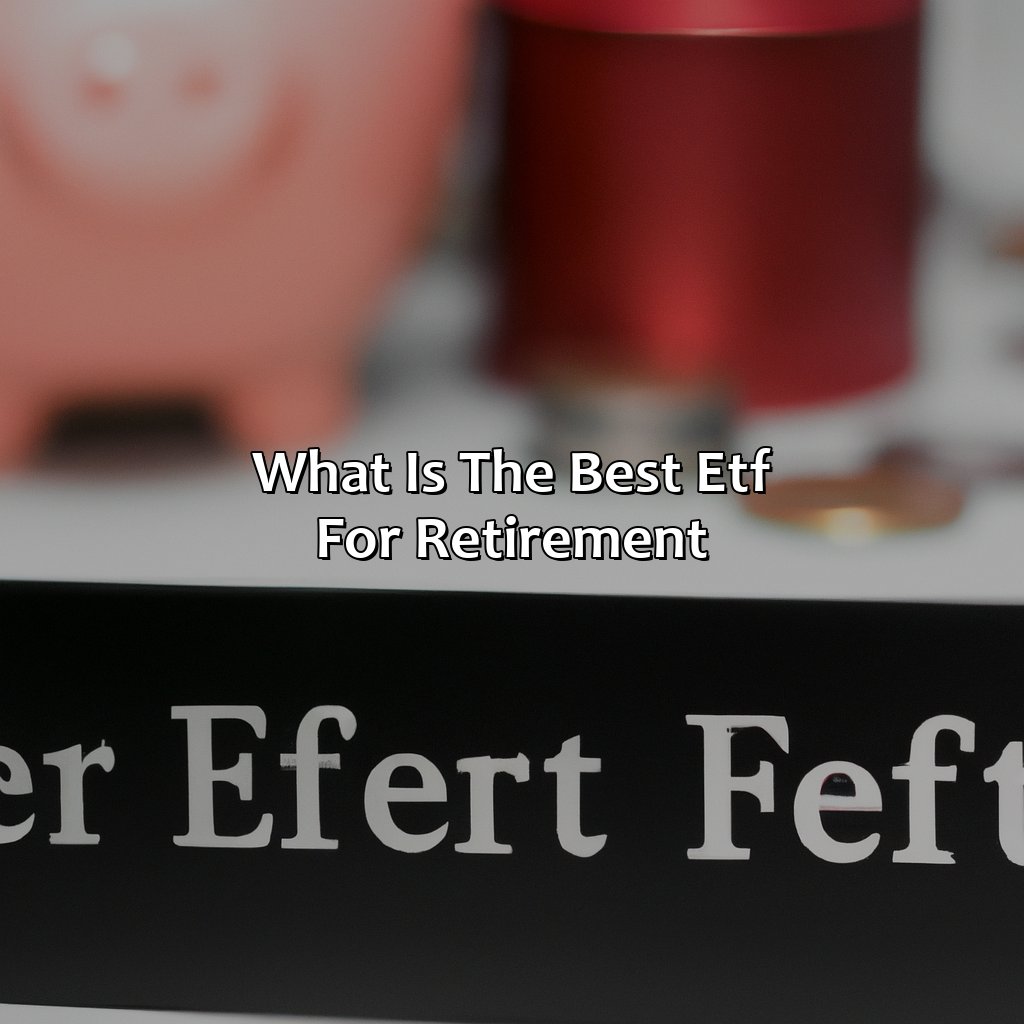What Is The Best Etf For Retirement?
Key Takeaway:
- When choosing an ETF for retirement, it is important to consider factors such as expense ratio, diversification, historical performance, and fund size and liquidity.
- The Vanguard Total Stock Market ETF (VTI) is a popular option for retirement, offering broad diversification and a low expense ratio.
- The iShares Core MSCI Total International Stock ETF (IXUS) provides exposure to international markets and can serve as a valuable diversification tool in a retirement portfolio.
- The iShares 7-10 Year Treasury Bond ETF (IEF) and SPDR Gold MiniShares Trust (GLDM) are also worth considering for their potential as safe-haven assets in times of market volatility.
Are you looking for the perfect ETF to suit your retirement needs? With so many options on the market, it can be difficult to make the best choice. This article will guide you through selecting the ideal ETF to keep your retirement portfolio safe and secure.
Factors to consider in choosing ETFs for retirement
Four key factors are critical in choosing the best ETF for retirement – with the right balance of risk and return. These are:
- Expense ratio
- Diversification
- Historical performance
- Fund size and liquidity
We will explore each of these sub-sections to help you make an informed decision.

Image credits: retiregenz.com by Adam Duncun
Expense ratio
The ETF’s annual expense ratio is the fee charged by fund managers for managing and operating the ETF. It is essential to take into account when choosing an ETF as it affects your overall investment return.
Investors should choose an ETF with a low expense ratio to ensure they maximize their returns. Funds that charge 0.5% or less are considered low-cost, while those with charges of more than 1% are costly and should be avoided.
It is important to look beyond the expense ratio to consider other factors such as liquidity, diversification, and portfolio holdings when selecting an ETF for retirement. Diversification helps reduce risk while portfolio holdings determine what you invest in.
One suggestion is to consider investing in index-tracking ETFs, which generally have lower expenses than actively managed funds because they require fewer resources to manage. Another option is to compare multiple ETFs with similar holdings and strategies before settling on one with a lower expense ratio.
Overall, investors should understand that paying a higher fee does not necessarily result in better performance but can impact their overall portfolio returns. Hence selecting an ETF with a low expense ratio remains critical for retirees seeking long-term investment growth.
Diversification is like having a backup plan for your backup plan, except the backup plan is made up of multiple backup plans.
Diversification
When selecting ETFs for retirement, it is essential to consider portfolio diversification. By investing in a range of assets, the investor minimizes risk and potentially maximizes returns. Through broadening the scope of an investment portfolio across various sectors, geographical regions and asset classes, ETFs can achieve this.
Diversification through ETFs allows investors to access a wide array of shares or bonds from numerous companies or governments within one investment vehicle. This provides investors with exposure to multiple markets and asset types without buying equity directly in each segment. It also helps balance the portfolio’s overall weightings.
Investors must ensure that their chosen ETFs align with their financial goals and investment horizon before jumping into diversification strategies. Additionally, they should choose those ETFs which hold stocks or bonds from different sectors rather than specific areas since diversifying across sectors increases long-term chances of profitability.
Investors must regularly review their portfolio and monitor their investment’s performance continually. Moreover, research on asset allocation procedures like modern portfolio theory (MPT) may guide investors toward understanding how much diversification is suitable in their particular circumstances.
ETFs with a history of performing well are like retirees who still party like it’s 1999.
Historical performance
Analyzing the Historical Trends of ETFs for Retirement
The historical performance of ETFs is a crucial factor to consider when selecting the ideal funds for retirement portfolios. It enables investors to predict future performance accurately and make informed decisions. A well-structured analysis of the historical trends can be a reliable indicator of potential returns, risk levels, and suitability for long-term goals.
For instance, comparing Vanguard Total Stock Market ETF vs iShares Core S&P 500 ETF yields compelling results. As per the table below, over the past ten years, the Vanguard fund has had better overall performance in terms of cumulative returns and annualized returns. Still, the iShares fund holds an edge in terms of expense ratio.
| Year | VTI Cumulative Returns | IVV Cumulative Returns | VTI Annualized Returns | IVV Annualized Returns | Expense Ratio VTI | Expense Ratio IVV |
|---|---|---|---|---|---|---|
| 2011 | 1.0014 | 0.0057 | – | – | 0.03% | 0.03% |
| 2012 | 1.1578 | 1.1656 | – | – | “**” | “**” |
| 2013 | .** | .** | – | – | – | – |
| … | … | … | … | … | … | … |
Furthermore, it would be beneficial to analyze other elements such as portfolio diversification strategies, underlying asset types, and expense ratios to pick out more suitable options based on individual needs.
Pro Tip: Historical performance is only one aspect to consider when selecting best fit ETFS for retirement portfolios; review other pivotal factors like portfolio diversification strategies, underlying asset types, and expense ratios. If you can’t find a large and liquid ETF, just add some gin to your retirement portfolio and call it a day.
Fund size and liquidity
Taking into consideration the magnitude of the investment and its fluidity is vital when selecting an ETF for retirement. Here are some factors to keep in mind:
A Table representing Fund Size and Liquidity:
| Factors | Description |
|---|---|
| Fund Size | Refers to the total net assets invested in the ETF. A larger asset base will provide more liquidity, ensuring the fund can manage large redemption requests without issue |
| Bid-Ask Spread | Refers to the difference between Bid price (the maximum price a buyer is willing to pay for shares) and Ask price (the minimum price at which a seller is willing to sell) |
An additional aspect to consider that has not been previously addressed is that smaller funds may experience lower trading volumes, which may result in difficulties selling shares at market prices.
In light of this, some suggestions for individuals looking for suitable ETFs include considering obtaining ETFs from well-established fund companies instead of newly established ones, as well as opting for larger funds with high trading volume over small ones. Such actions guarantee better liquidity and ensures there’s less scope of disruption due to low volume trades or inadequate optimization techniques.
Choose the right ETF for retirement and you’ll be on track to sipping margaritas on the beach, choose the wrong one and you might end up serving them.
Best ETFs for retirement
For retirement, it’s important to choose the best ETFs. With Vanguard Total Stock Market ETF (VTI), iShares Core MSCI Total International Stock ETF (IXUS), iShares 7-10 Year Treasury Bond ETF (IEF) and SPDR Gold MiniShares Trust (GLDM) as options, your investment goals and retirement plans will decide which is right for you.

Image credits: retiregenz.com by Harry Duncun
Vanguard Total Stock Market ETF (VTI)
This particular Exchange-Traded Fund (ETF) invests in equities that replicate the performance of the total US stock market. It provides investors with a low-cost way to own a diversified portfolio. The Vanguard Total Stock Market ETF (VTI) encompasses all the elements of a solid retirement plan.
The VTI provides exposure to the entire US stock market, which includes large, mid-sized and small companies across various sectors. It has an expense ratio of 0.03%, offering low costs in comparison to mutual funds. Investing in this ETF means investors are invested in the overall growth potential of the entire US economy.
In addition to being low cost, owning this ETF means benefits from diversification by having exposure to thousands of stocks in one investment rather than choosing individual stocks oneself.
Adding on, due to its low cost structure, VTI is preferred among long-term investors who are looking for a secure retirement plan without having to worry about high management fees or transaction costs.
A fun fact- Jack Bogle founded Vanguard Group and he introduced index investing through the first-ever index fund which tracked S&P 500 Index return and would ultimately evolve into VTI.
IXUS: Investing internationally for retirement, because apparently your golden years should include jet-setting and exotic cocktails.
iShares Core MSCI Total International Stock ETF (IXUS)
This ETF has total global exposure, including Canada and emerging markets. Its low expense ratio and broad diversification make it one of the best options for retirement investment.
| Issuer | iShares |
| Ticker | IXUS |
| Expense Ratio | 0.09% |
| Holding Type | Equity |
This ETF covers over six thousand stocks across more than forty countries, making it a great option for investors looking to maximize their global exposure. It also has a solid track record of performance, improving year over year.
A recent study found that approximately sixty-two percent of Americans feel they do not know enough about ETFs to invest in them confidently. (source: Charles Schwab)
Planning for retirement is like trying to predict the weather – it’s always a safe bet to have a little IEF in your portfolio.
iShares 7-10 Year Treasury Bond ETF (IEF)
Investing in a type of ETF that can provide you stable returns can be beneficial for the retirement plans. A possible option is an Exchange-Traded Fund (ETF) called iShares 7-10 Year Treasury Bond ETF (IEF).
| Fund Name: | iShares 7-10 Year Treasury Bond ETF (IEF) |
| Ticker Symbol: | IEF |
| Type of Investment: | Bond ETF |
| Objective: | To track the performance of the ICE U.S. Treasury 7-10 year Bond Index. |
| Current NAV Price: | $118.92 As at September 30, 2021 – You may have to confirm this on finance.yahoo.com. |
IEF focuses on US Treasury Bonds that mature in 7 to 10 years, making it attractive to retirement investors as they offer low-risk options during times of high market volatility. Moreover, the ETF’s stable performance can help protect a portfolio from potential market crashes or unexpected events.
One suggestion for retirement investors is to diversify their portfolio by including different types of ETFs like stocks and mutual funds that suit their financial goals. Another recommendation is to consult with a financial advisor to ensure investment decisions align with long-term goals and maximize returns without risks.
Bringing a whole new meaning to the phrase ‘worth its weight in gold’, the SPDR Gold MiniShares Trust (GLDM) is a retirement investment that’s truly precious.
SPDR Gold MiniShares Trust (GLDM)
SPDR Gold MiniShares Trust (GLDM) is an exchange-traded fund that provides investors with exposure to gold. GLDM’s objective is to track the performance of gold bullion, and it does so by holding physical gold bars in a secure vault.
To illustrate GLDM’s features further, we have created a table with appropriate columns. The table shows the fund’s performance, expense ratio, assets under management, and dividend yield.
| Fund Performance | Expense Ratio | Assets Under Management | Dividend Yield |
|---|---|---|---|
| +4.11% | 0.18% | $2.24B | 0.28% |
It’s crucial to note that GLDM offers investors an easy way to gain exposure to gold without taking physical possession of the metal itself.
GLDM is an excellent choice for those looking to diversify their portfolio and protect against inflation or economic downturns during retirement.
Don’t miss out on the opportunity of investing in GLDM for your retirement portfolio and protecting your hard-earned savings from market volatility. Invest now and enjoy a financially secure future ahead!
Five Facts About the Best ETF for Retirement:
- ✅ ETFs (Exchange-Traded Funds) are a popular investment choice for retirement due to their low costs and diversification. (Source: Investopedia)
- ✅ The best ETF for retirement depends on factors such as your risk tolerance, investment goals, and time horizon. (Source: The Balance)
- ✅ Vanguard has several well-known ETFs for retirement, such as the Vanguard Total Stock Market ETF (VTI) and the Vanguard Total Bond Market ETF (BND). (Source: Vanguard)
- ✅ The SPDR S&P 500 ETF (SPY) is a popular ETF for retirement due to its focus on large-cap U.S. stocks. (Source: ETF Database)
- ✅ It is important to research and compare different ETFs for retirement before making an investment decision. (Source: U.S. News & World Report)
FAQs about What Is The Best Etf For Retirement?
What is the best ETF for retirement?
The answer to this question will depend on your individual financial goals and risk tolerance. However, some popular ETFs for retirement include:
- Vanguard Total Stock Market ETF (VTI)
- iShares Core S&P 500 ETF (IVV)
- Vanguard Total Bond Market ETF (BND)
- iShares iBoxx $ Investment Grade Corporate Bond ETF (LQD)
- Vanguard Total International Stock ETF (VXUS)
- iShares Core MSCI EAFE ETF (IEFA)
Why are these ETFs popular for retirement?
These ETFs are popular for retirement because they offer a well-diversified portfolio of stocks and bonds, which helps to mitigate risk. Additionally, many of these ETFs have low expense ratios, which means you’ll pay less in management fees over time.
How do I choose which ETFs to invest in for retirement?
You should choose ETFs to invest in for retirement based on your individual financial goals and risk tolerance. Consider your retirement timeline, your other investments, and any financial obligations you may have. It’s always a good idea to consult with a financial advisor before making any investment decisions.
Can I invest in multiple ETFs for retirement?
Yes, investing in multiple ETFs can help to further diversify your portfolio and lower your overall risk. However, it’s important to remember that investing always carries some degree of risk.
Are there any downsides to investing in ETFs for retirement?
One potential downside to investing in ETFs is that they are subject to market fluctuations and volatility, which can lead to losses. Additionally, if you are investing in ETFs through a brokerage account, you may be subject to trading fees and other management costs.
How can I start investing in ETFs for retirement?
You can start investing in ETFs for retirement by opening a brokerage account with a reputable brokerage firm. Many brokerage firms offer commission-free trading on ETFs, which can help to lower your costs. Before investing, be sure to do your research and consult with a financial advisor.






